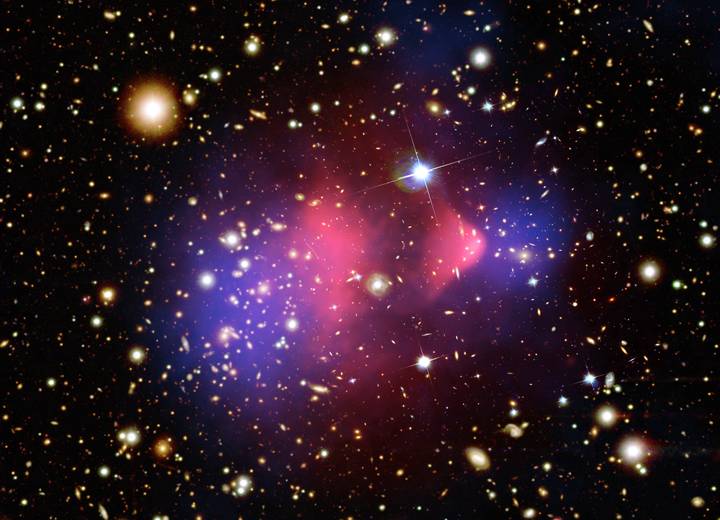
_____________________________________________________________

_____________________________________________________________
National Aeronautics and Space Administration
NASA Headquarters
Washington, D.C.
November 1994
All visible celestial objects known today account for only 10% of the mass in the universe.
The rest of this "missing mass", also known as "dark matter",
is presumably invisible because it does not emit or reflect visible light or other forms of electromagnetic radiation.
Or perhaps its light is so feeble that current astronomical instruments are unable to detect it.
However, dark matter can be indirectly detected due to its gravitational influence on other nearby visible objects.
The presence of dark matter was first discovered in 1932 by astronomer Jan Oort, who measured the perpendicular motions of nearby stars relative to the disk of our Milky Way. He studied the gravitational influence of the galactic disk on these stars, and so, was able to measure the mass of the disk (just as the mass of Earth can be calculated from the acceleration of a falling object). To his surprise, this calculated mass was twice the amount of mass seen as stars and nebulae. A year later, Fritz Zwicky examined the dynamics of clusters of galaxies, and also came to the startling conclusion that the observed galaxies only accounted for 10% of the mass needed to gravitationally bind the galaxies in the cluster.
One widely used method to deduce the amount of missing mass involves measuring the rotation speed of a spiral galaxy. Spectroscopic and radio observations have obtained the rotation velocities of hundreds of spiral galaxies. These experiments have revealed that, in most cases, a galaxy's mass continues to increase toward the edge of its visible disk of stars. This implies that spiral galaxies are surrounded in haloes of matter that cannot be seen. Observations of elliptical galaxies, groups, and clusters of galaxies also indicate the presence of dark matter interacting gravitationally with the visible objects.
The nature of dark matter, and its abundance, are among the most important questions in modern cosmology today.
What is it made of?
Some astronomers believe that dark matter is composed of protons and neutrons, called baryonic or simply "normal" matter.
Baryonic dark matter candidates include extra-solar planets, remnants of stellar evolution such as comets,
objects not massive enough to ignite hydrogen fusion called brown dwarfs,
dying embers of stars such as cold white dwarfs and neutron stars, as well as interstellar and intergalactic gases.
Non-baryonic dark matter, on the other hand, could be elementary particles that do not interact strongly with normal matter. Except for the neutrino particle, many such elementary particles are still in the realm of theory and have not been detected.
Since all visible matter is only a small fraction of the total mass in the universe, the amount of dark mass that is present will determine the evolutionary future of the universe. If there is not enough dark matter to gravitationally bind the universe together, it could continue expanding forever. If there is enough mass in the universe to gravitationally hold it together, the universe may slow down its expansion, come to a halt, and begin to contract and eventually collapse.
The temperature of dark matter in the early universe also may have determined the early evolution of the universe. Not long after the Big Bang and prior to the formation of galaxies, matter began to aggregate under the influence of gravity. Dark matter might have provided the "seeds", a lumpy background in which ordinary matter could congregate to form galaxies and stars. If this "cold dark matter" were present, where particles had a negligible random motion, galaxy formation would begin on small scales. Matter would gather in sizes comparable to current galaxies or smaller, and eventually build to become clusters and superclusters due to the gravitational attraction of the galaxies.
If, however, "warm dark matter" was present, it would erase the small galaxy-sized "seeds" that initially formed. Instead, enormous gaseous pancake-like structures as large as superclusters and clusters are created, subsequently condensing into individual galaxies.
For more information and pictures, link to
Dark Matter
(HubbleSite - NewsCenter - Background, October 17, 1994).

Erica Hupp, Headquarters, Washington.
Steve Roy, Marshall Space Flight Center, Huntsville, Ala.
Megan Watzke, Chandra X-ray Center, Cambridge, Mass.
News release 06-096 (August 8 '06)
Dark matter [blue colored] and normal matter [red colored] have been wrenched apart
by the tremendous collision of two large clusters of galaxies.
The discovery, using NASA's Chandra X-ray Observatory and other telescopes, gives direct evidence for the existence of dark matter.
"This is the most energetic cosmic event, besides the Big Bang, which we know about", said team member Maxim Markevitch of the Harvard-Smithsonian Center for Astrophysics in Cambridge, Mass.
These observations provide the strongest evidence yet that most of the matter in the universe is dark. Despite considerable evidence for dark matter, some scientists have proposed alternative theories for gravity where it is stronger on intergalactic scales than predicted by Newton and Einstein, removing the need for dark matter. However, such theories cannot explain the observed effects of this collision.
"A universe that's dominated by dark stuff seems preposterous, so we wanted to test whether there were any basic flaws in our thinking", said Doug Clowe of the University of Arizona at Tucson, and leader of the study. "These results are direct proof that dark matter exists".
In galaxy clusters, the normal matter, like the atoms that make up the stars, planets, and everything on Earth, is primarily in the form of hot gas and stars. The mass of the hot gas between the galaxies is far greater than the mass of the stars in all of the galaxies. This normal matter is bound in the cluster by the gravity of an even greater mass of dark matter. Without dark matter, which is invisible and can only be detected through its gravity, the fast-moving galaxies and the hot gas would quickly fly apart.
The team was granted more than 100 hours on the Chandra telescope to observe the galaxy cluster 1E0657-56. The cluster is also known as the bullet cluster, because it contains a spectacular bullet-shaped cloud of hundred-million-degree gas. The X-ray image shows the bullet shape is due to a wind produced by the high-speed collision of a smaller cluster with a larger one.
In addition to the Chandra observation, the Hubble Space Telescope, the European Southern Observatory's Very Large Telescope and the Magellan optical telescopes were used to determine the location of the mass in the clusters. This was done by measuring the effect of gravitational lensing, where gravity from the clusters distorts light from background galaxies as predicted by Einstein's theory of general relativity.
The hot gas in this collision was slowed by a drag force, similar to air resistance. In contrast, the dark matter was not slowed by the impact, because it does not interact directly with itself or the gas except through gravity. This produced the separation of the dark and normal matter seen in the data. If hot gas was the most massive component in the clusters, as proposed by alternative gravity theories, such a separation would not have been seen. Instead, dark matter is required.
"This is the type of result that future theories will have to take into account", said Sean Carroll, a cosmologist at the University of Chicago, who was not involved with the study. "As we move forward to understand the true nature of dark matter, this new result will be impossible to ignore".
This result also gives scientists more confidence that the Newtonian gravity familiar on Earth and in the solar system also works on the huge scales of galaxy clusters.
"We've closed this loophole about gravity, and we've come closer than ever to seeing this invisible matter", Clowe said.
These results are being published in an upcoming issue of The Astrophysical Journal Letters.
NASA's Marshall Space Flight Center, Huntsville, Ala., manages the Chandra program. The Smithsonian Astrophysical Observatory controls science and flight operations from the Chandra X-ray Center, Cambridge, Mass.
For more information, pictures, and video, link to
NASA Finds Direct Proof of Dark Matter
(at the Web site of NASA).
And
1E 0657-56: NASA Finds Direct Proof of Dark Matter
(at the Web site of the The Chandra X-ray Observatory Center).
See also: Hubble Finds Ring of Dark Matter (Observatorio ARVAL, 06-06-2007)
![]() Updated: June 6 '07
Updated: June 6 '07
Best seen with MS Internet Explorer.
Back: STScI - Background Information
Messages: